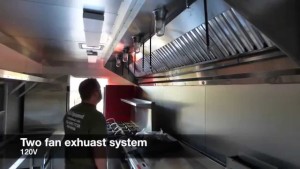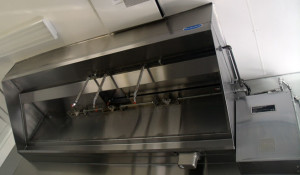The heart and soul of a kitchen line can be debated up and down, at least when considering the purely mechanical aspect of it, but one can say with full confidence that the backbone is none other than one’s Hood System. The angled vented metal thingies hanging over every line of ranges and other cooking rigs, no indoor kitchen can properly function without these behemoths overhead, and that includes Food Trucks.
These are the chimneys and air vacuums of our culinary world, sucking up all steam, smoke, and other cast-offs from the hours we spend cooking up and through their vented structures and out harmlessly into the air outside your truck, keeping the interior from clogging with a ‘cooking fog’ keeping you from seeing to your sauté pan, let alone breathing. But they do much more duty than just an upgraded ‘open window;’ hood systems have a very important duty in one of the many ‘vapors’ they catch, oil mists that spray up from the fryer and other equipment, which can normally cling to walls and equipment slowly over time, creating this disturbingly discolored, sticky, scummy layer of disgustingess. Not to mention they help to release some of the heat buildup; you wouldn’t think so with how hot these trucks get, and yes it’s not much, but believe me it still helps.
As such, it’s of the greatest importance to ensure you can then get your hands on a proper system for your truck, supposing you didn’t buy a pre-owned that was already installed. So what’s there to know about that?
Well first off, most of this will actually have to be determined for yourself. Apparently different state and regional regulations and requirements on hood systems, what codes they meet, what dimensions they fit, how the hoods and ventilation system can be arranged in your truck/distance it can be from various other equipment, how and who installs it, where you can and can’t get, etc, all vary quite widely. Though one should prepare to have a professional install it; doesn’t matter if you can do it perfectly, the regulators will often require that an outside source do this so that they KNOW it’s up to code (or to collect some more taxes, we’ll let you decide which opinion to stick to).
 When it comes to actually finding and purchasing a hood system, there are plenty of options under your belt. Starting off is going straight for a Custom hood system for your vehicle, either from a truck Builder; notably more costly, but much like a smoker it offers the ability to find that system that is absolutely perfect for your kitchen needs and design. Secondly, plenty of restaurant equipment depos and concession hood manufacturers sell pre-made, ready-to-install hoods and hood packages, including the fire suppressant systems, to fit most kitchen and even food truck situations. Most of these should be more reasonable than custom, but still pricey, and can be an easy way to just get it done and installed without any thought. Finally, one can also explore used ventilation hoods, if your region’s rules allows it; obviously cheaper, probably much harder to find one that will fit your kitchen properly and to local certification, and once done so chances are you will need to spend a LOT of long, exhausting effort to clean it by hand inside and out. That said, a clean, regular used ventilation will keep working just as well as a brand new, assuming of course it’s not banged up and used to within an inch of its life beforehand. The caveat is that, most likely, you’ll still be required by your regional codes to have it installed by a professional once ready.
When it comes to actually finding and purchasing a hood system, there are plenty of options under your belt. Starting off is going straight for a Custom hood system for your vehicle, either from a truck Builder; notably more costly, but much like a smoker it offers the ability to find that system that is absolutely perfect for your kitchen needs and design. Secondly, plenty of restaurant equipment depos and concession hood manufacturers sell pre-made, ready-to-install hoods and hood packages, including the fire suppressant systems, to fit most kitchen and even food truck situations. Most of these should be more reasonable than custom, but still pricey, and can be an easy way to just get it done and installed without any thought. Finally, one can also explore used ventilation hoods, if your region’s rules allows it; obviously cheaper, probably much harder to find one that will fit your kitchen properly and to local certification, and once done so chances are you will need to spend a LOT of long, exhausting effort to clean it by hand inside and out. That said, a clean, regular used ventilation will keep working just as well as a brand new, assuming of course it’s not banged up and used to within an inch of its life beforehand. The caveat is that, most likely, you’ll still be required by your regional codes to have it installed by a professional once ready.
Something that is efficient and performs the tasks we’ve listed earlier, leaving you able to cook and serve your food with no worries, that is what you are trying to get. Look for reviews on custom builders, pre-made products, or if used then query the pre-owners if possible, FIND OUT how well the one/s you’re looking at work/ed and how this compares to other options on the market.
When finally deciding to get a hood for your operation, note that those used in Food Trucks usually have to be designed differently for the space compared to restaurants (one of the reasons why it’s so ideal to get a Custom system if you can afford it) but there are plenty of places one can buy those designed specifically for food truck use. These features often include things like a shallow front design to fit the small space, the back dropping down closer to the cooking surface to better pick up grease vapors, smoke, and other fumes.
You’ll ideally want, and likely be required, to have your hood system 6” wider on each side than the line of cooking equipment; your range, grills, fryers, etc. Which is often why these vents often just go wall-to-wall over a truck’s kitchen line.
After purchase, they must now be kept spick and span in order to continue efficient running. Going through the annoyingly long, messy, and thorough cleaning process a MINIMUM once every 3 months; believe me, I’ve done it, the buildup is not a pretty sight even at that point, I doubt you’ll want to tackle something that’s waited even longer.
 Finally, there’s one last thing to be aware of: Fire Suppressant Systems. Some states require them, there are some that don’t see the need of such an intensive range-destroying system in such a small space (being mainly last-ditch, complete fire-suppressant measures that make a huge mess of the kitchen but make sure it doesn’t spread to take down a whole building… as opposed to a single truck) when a fire extinguisher will do just the trick. Whatever the situation, and whatever your decision if given the choice, these are usually installed along with the hoods, so the same options for who to get them from still apply, except these one will likely NOT want to buy used; if anything just to avoid the evil eyes of the health and safety regulation people.
Finally, there’s one last thing to be aware of: Fire Suppressant Systems. Some states require them, there are some that don’t see the need of such an intensive range-destroying system in such a small space (being mainly last-ditch, complete fire-suppressant measures that make a huge mess of the kitchen but make sure it doesn’t spread to take down a whole building… as opposed to a single truck) when a fire extinguisher will do just the trick. Whatever the situation, and whatever your decision if given the choice, these are usually installed along with the hoods, so the same options for who to get them from still apply, except these one will likely NOT want to buy used; if anything just to avoid the evil eyes of the health and safety regulation people.
Those are the basics. Stick to these keys, expanding upon it when local regulations deems more research into different components/procedures, and you should do fine in finding the right hood for your mobile operation. We wish you luck in the search for this all-important kitchen line component, and feel free to send us here at M&R a message or phone call if any other questions need answering towards this end!
See Also:
Vent Hoods Explained – a helpful write-up that talks about different calculations and considerations of vent hood stats and effects for a restaurants use, for those who want to get a bit more in-depth about it.

Leave A Comment